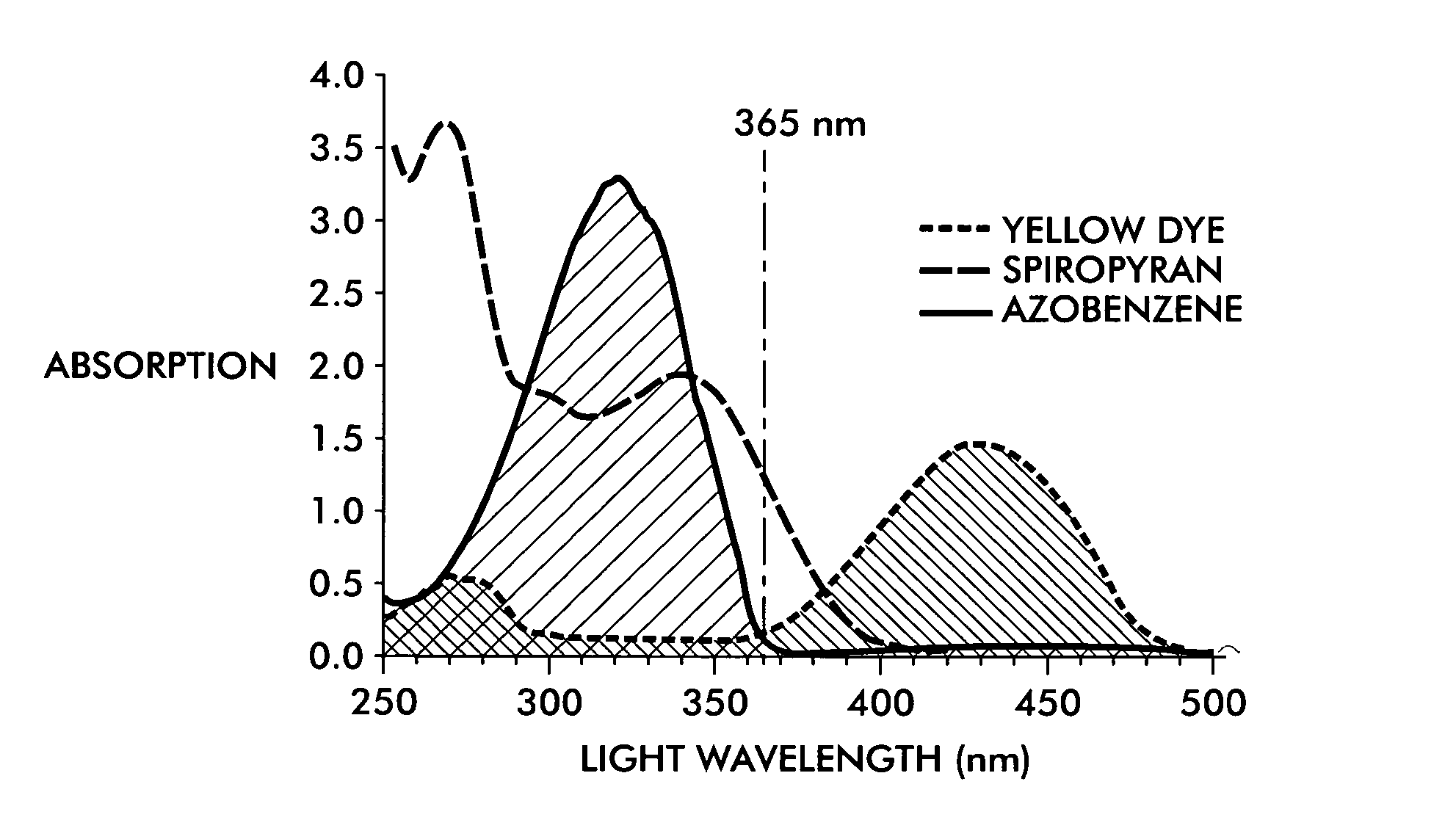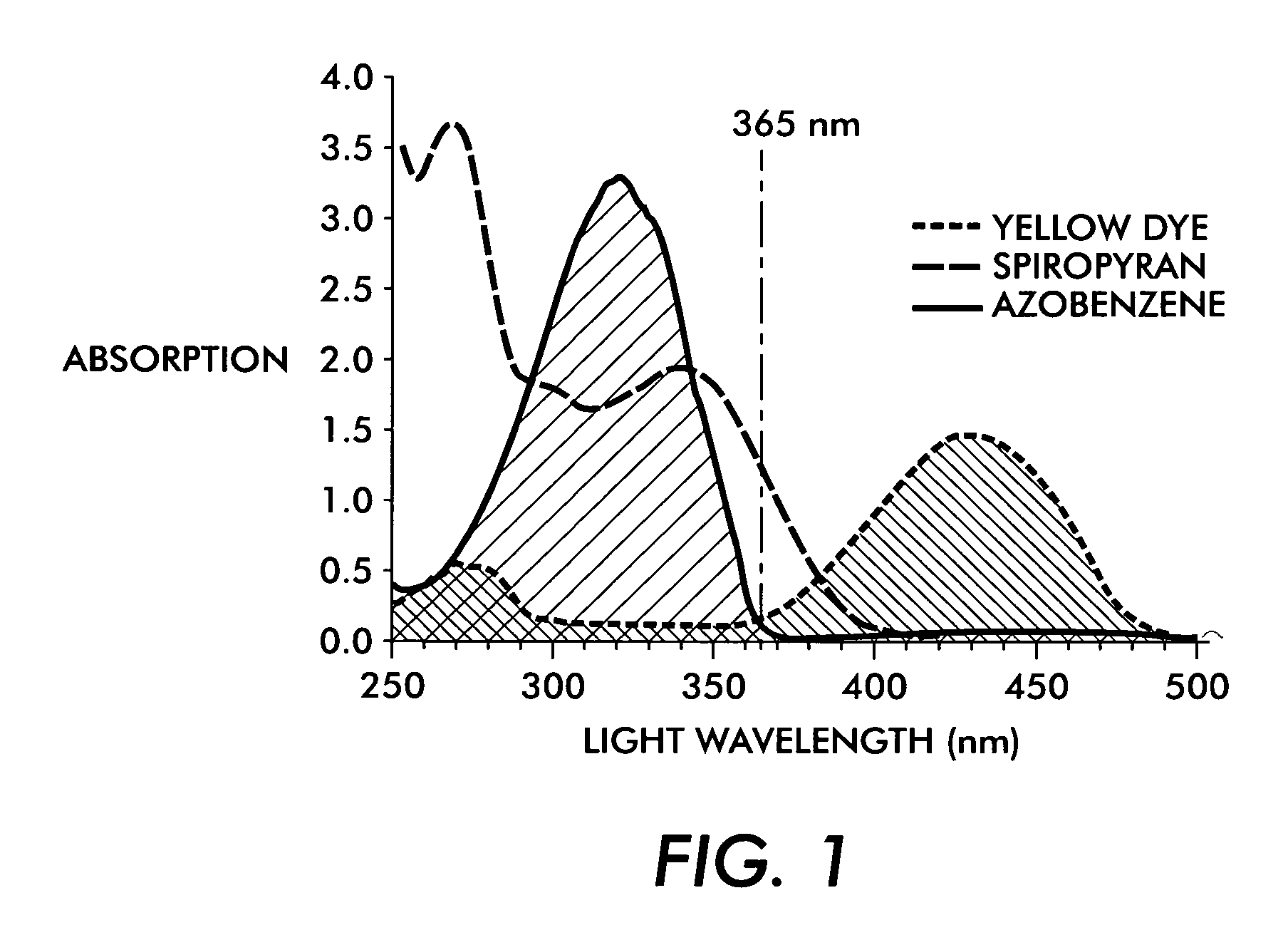Reimageable medium with light absorbing material
a technology of light absorbing material and reimageable medium, which is applied in the direction of photosensitive materials, instruments, photomechanical equipment, etc., can solve the problems of significant environmental environmental and economic costs, the disposal of discarded paper documents, and the enormous quantity of paper documents
- Summary
- Abstract
- Description
- Claims
- Application Information
AI Technical Summary
Benefits of technology
Problems solved by technology
Method used
Image
Examples
example 1
[0235]A solution was prepared by dissolving 7.5 g of polymeric binder (polymethyl methacrylate, Mw=33,000) and 0.9 g of a 1′,3′-dihydro-1′,3′,3′-trimethyl-6-nitrospiro-(2H-1-benzopyran-2,2′-(2H)-indole (photochromic material) in a mixture of solvents made of 20 ml THF and 10 ml toluene. After dissolution, a solid film was prepared by doctor-blade on a flexible MYLAR™ sheet. Film thickness was about 10 microns. The film was dried at ambient temperature for 3 hours then in the oven for 30 minutes to ensure solvent removal. The film was protected by laminating with a second sheet of MYLAR™ plastic placed on top of it, to prevent degradation from scratching, then the bottom of the display was painted white. The reimageable medium was written by illumination with UV light (365 nm) of intensity of about 4 mW / cm2 through a mask containing the negative of the image to be shown. After writing, the temporary image was visible for about 4 hours. After leaving the reimageable medium under an in...
example 2
[0240]Regular white paper (XEROX™ multipurpose 1524 paper) was soaked into a solution containing 7.5 g of polymeric binder (polymethyl methacrylate, Mw=33,000) and 0.9 g of 1′,3′-dihydro-1′,3′,3′-trimethyl-6-nitrospiro-(2H-1-benzopyran-2,2′-(2H)-indole (photochromic material) in 80 ml of THF. After dipping, the paper sheet was air dried, yielding a dry sheet of paper impregnated with the photochromic material. The paper was imaged by illumination with UV light (365 nm; 2.5 mW / cm2) through a mask. The temporary image was visible for about 4 hours. After leaving the reimageable medium under an indoor ambient condition for about 16–20 hours (this total included the about 4 hours that the temporary image was visible), the temporary image faded completely, so that the reimageable medium was ready to be re-imaged. About 20 cycles of temporary image formation / temporary image erasure were performed on the same sheet of paper.
example 3
[0241]A stock polymeric solution was prepared by dissolving 15 g of PMMA 33K in 40 ml THF and 20 ml Toluene. A first sample (sample #1) was made by spin-coating on a quartz slide of a solution containing 100 mg of spiropyran (1′,3′-dihydro-1′,3′,3′-trimethyl-6-nitrospiro-(2H-1-benzopyran-2,2′-(2H)-indole) and 100 mg of azobenzene (UV light absorbing material) dissolved into 5 ml stock polymeric solution. A comparison sample (sample #2) was made in the same way from a solution containing 100 mg spiropyran dissolved in 5 ml of the above polymeric solution (no light absorbing material added).
[0242]Sample #1 (containing spiropyran with UV light absorbing material) and sample #2 (containing only spiropyran) were left under indoor ambient light for 4 hours. The degree of coloration of blank areas by the UV component of the indoor ambient light was measured as increased absorbance at 575 nm (maximum of absorbance of the colored form of the photochromic component). Sample #1 measured an abs...
PUM
| Property | Measurement | Unit |
|---|---|---|
| wavelength band | aaaaa | aaaaa |
| wavelength band | aaaaa | aaaaa |
| wavelength band | aaaaa | aaaaa |
Abstract
Description
Claims
Application Information
 Login to View More
Login to View More - R&D
- Intellectual Property
- Life Sciences
- Materials
- Tech Scout
- Unparalleled Data Quality
- Higher Quality Content
- 60% Fewer Hallucinations
Browse by: Latest US Patents, China's latest patents, Technical Efficacy Thesaurus, Application Domain, Technology Topic, Popular Technical Reports.
© 2025 PatSnap. All rights reserved.Legal|Privacy policy|Modern Slavery Act Transparency Statement|Sitemap|About US| Contact US: help@patsnap.com



